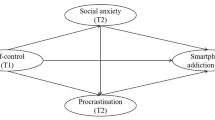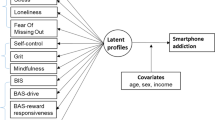Abstract
Excessive smartphone use has recently attracted researchers’ attention. Previous studies have suggested that state anxiety and motivations are important predictors of excessive smartphone use. However, few studies have investigated how motivations and state anxiety interact with each other, and the subsequent impact on excessive smartphone use. In the current study, based on the Compensatory Internet Use theory, we analyzed the moderating role of state anxiety on the relationship between two types of motivations (i.e. entertainment and social interaction) and excessive smartphone use. Using the Smartphone Addiction Scale for College Students (SAS-C), Smartphone Usage Motivation Scale and State Anxiety Scale (S-Anxiety), we investigated 600 Chinese college students who identified themselves as smartphone users. Results indicated that: (1) for the high smartphone-use group, state anxiety moderates the relationship between entertainment and social interaction motivations and excessive smartphone use; (2) for the low smartphone-use group, state anxiety does not moderate the relationship between entertainment and social interaction motivations and excessive smartphone use. Our study emphasized the importance of psychological well-being variables (i.e. anxiety in this study) in facilitating excessive smartphone use, and may provide guidance for the design of interventions targeted at people suffering from excessive smartphone use.






Similar content being viewed by others
References
Aiken, L. S., West, S. G., & Reno, R. R. (1991). Multiple regression: Testing and interpreting interactions: Sage.
Bian, M. W., & Leung, L. (2015). Linking loneliness, shyness, smartphone addiction symptoms, and patterns of smartphone use to social capital. Social Science Computer Review, 33(1), 61–79.
Blumler, J. G., Katz, E., & Blumler, J. G. (1974). The uses of mass communications: Current perspectives on gratifications research (Vol. 3): Sage publications Beverly Hills, CA.
Chen, H. T., & Kim, Y. (2013). Problematic use of social network sites: The interactive relationship between gratifications sought and privacy concerns. Cyberpsychology, Behavior and Social Networking, 16(11), 806–812.
Chesley, N. (2005). Blurring boundaries? Linking technology use, spillover, individual distress, and family satisfaction. Journal of Marriage and Family, 67(5), 1237–1248.
Chou, C., & Hsiao, M. C. (2000). Internet addiction, usage, gratification, and pleasure experience: The Taiwan college students' case. Computers & Education, 35(1), 65–80.
Cohen, J., Cohen, P., West, S. G., & Aiken, L. S. (2013). Applied multiple regression/correlation analysis for the behavioral sciences: Routledge.
Hong, F. Y., Chiu, S. I., & Huang, D. H. (2012). A model of the relationship between psychological characteristics, mobile phone addiction and use of mobile phones by Taiwanese university female students. Computers in Human Behavior, 28(6), 2152–2159.
Jenaro, C., Flores, N., Gomez-Vela, M., Gonzalez-Gil, F., & Caballo, C. (2007). Problematic internet and cell-phone use: Psychological, behavioral, and health correlates. Addiction Research & Theory, 15(3), 309–320.
Kardefelt-Winther, D. (2014a). A conceptual and methodological critique of internet addiction research: Towards a model of compensatory internet use. Computers in Human Behavior, 31, 351–354.
Kardefelt-Winther, D. (2014b). The moderating role of psychosocial well-being on the relationship between escapism and excessive online gaming. Computers in Human Behavior, 38, 68–74.
Kardefeltwinther, D., Heeren, A., Schimmenti, A., Van, R. A., Maurage, P., Carras, M., et al. (2017). How can we conceptualize behavioural addiction without pathologizing common behaviours? Addiction, 112(10), 1709–1715.
Knobloch-Westerwick, S., Hastall, M. R., & Rossmann, M. (2009). Coping or escaping? Effects of life dissatisfaction on selective exposure. Communication Research, 36(2), 207–228.
Kuss, D. J., & Griffiths, M. D. (2011). Online social networking and addiction—A review of the psychological literature. International Journal of Environmental Research and Public Health, 8(9), 3528–3552.
Kwon, M., Kim, D. J., Cho, H., & Yang, S. (2013a). The smartphone addiction scale: Development and validation of a short version for adolescents. PLoS One, 8(12), e83558.
Kwon, M., Lee, J. Y., Won, W. Y., Park, J. W., Min, J. A., Hahn, C., Gu, X., Choi, J. H., & Kim, D. J. (2013b). Development and validation of a smartphone addiction scale (SAS). PLoS One, 8(2), e56936.
Lee, C. S., & Ma, L. (2012). News sharing in social media: The effect of gratifications and prior experience. Computers in Human Behavior, 28(2), 331–339.
Lee, Y. K., Chang, C. T., Lin, Y., & Cheng, Z. H. (2014). The dark side of smartphone usage: Psychological traits, compulsive behavior and technostress. Computers in Human Behavior, 31, 373–383.
Lo, S. K., Wang, C. C., & Fang, W. (2005). Physical interpersonal relationships and social anxiety among online game players. Cyberpsychology & Behavior, 8(1), 15–20.
Martinotti, G., Villella, C., Di Thiene, D., Di Nicola, M., Bria, P., Conte, G., et al. (2011). Problematic mobile phone use in adolescence: A cross-sectional study. Journal of Public Health, 19(6), 545–551.
Muthén, L. K., & Muthén, B. O. (2010). Mplus User's Guide: Statistical Analysis with Latent Variables: User'ss Guide: Muthén & Muthén.
Panova, T., & Carbonell, X. (2018). Is smartphone addiction really an addiction? Journal of Behavioral Addictions, 7(2), 252–259.
Park, N., Kee, K. F., & Valenzuela, S. (2009). Being immersed in social networking environment: Facebook groups, uses and gratifications, and social outcomes. Cyberpsychology & Behavior, 12(6), 729–733.
Pawlikowski, M., Nader, I. W., Burger, C., Stieger, S., & Brand, M. (2014). Pathological internet use–it is a multidimensional and not a unidimensional construct. Addiction Research & Theory, 22(2), 166–175.
Raacke, J., & Bonds-Raacke, J. (2008). MySpace and facebook: Applying the uses and gratifications theory to exploring friend-networking sites. Cyberpsychology & Behavior, 11(2), 169–174.
Smock, A. D., Ellison, N. B., Lampe, C., & Wohn, D. Y. (2011). Facebook as a toolkit: A uses and gratification approach to unbundling feature use. Computers in Human Behavior, 27(6), 2322–2329.
Spielberger, C. D. (1985). Assessment of trait and state anxiety: Conceptual and methodological issues. The Southern Psychologist, 2(4), 6-16.
Stuart, J. B., Pressy, A. D., & Scornavacca, E. (2019). Mobile ubiquity: Understanding the relationship between cognitive absorption, smartphone addiction and social network services. Computers in Human Behavior, 90, 246–258.
Su, S., Pan, T. T., Liu, X. Q., Chen, X. W., Wang, Y. J., & Li, M. Y. (2014). Development of the smartphone addiction scale for college students. Chinese Mental Health Journal, 28(5), 392–397.
Takao, M., Takahashi, S., & Kitamura, M. (2009). Addictive personality and problematic mobile phone use. Cyberpsychology & Behavior, 12(5), 501–507.
Tang, J., Yu, Y., Du, Y., Ma, Y., Zhang, D., & Wang, J. (2014). Prevalence of internet addiction and its association with stressful life events and psychological symptoms among adolescent internet users. Addictive Behaviors, 39(3), 744–747.
Thomée, S., Eklöf, M., Gustafsson, E., Nilsson, R., & Hagberg, M. (2007). Prevalence of perceived stress, symptoms of depression and sleep disturbances in relation to information and communication technology (ICT) use among young adults–an explorative prospective study. Computers in Human Behavior, 23(3), 1300–1321.
Thomée, S., Härenstam, A., & Hagberg, M. (2011). Mobile phone use and stress, sleep disturbances, and symptoms of depression among young adults-a prospective cohort study. BMC Public Health, 11(1), 66.
Walsh, S. P., White, K. M., & Young, R. M. (2008). Over-connected? A qualitative exploration of the relationship between Australian youth and their mobile phones. Journal of Adolescence, 31(1), 77–92.
Wang, L. J. (2008). Investigating into State anxiety among primary and middle school teachers in China. (Doctoral dissertation), Southwest University.
Wang, J. L., Jackson, L. A., Wang, H. Z., & Gaskin, J. (2015a). Predicting social networking site (SNS) use: Personality, attitudes, motivation and internet self-efficacy. Personality and Individual Differences, 80, 119–124.
Wang, J. L., Wang, H. Z., Gaskin, J., & Wang, L. H. (2015b). The role of stress and motivation in problematic smartphone use among college students. Computers in Human Behavior, 53, 181–188.
Wei, R. (2006). Staying connected while on the move: Cell phone use and social connectedness. New Media & Society, 8(1), 53–72.
Wei, R. (2008). Motivations for using the mobile phone for mass communications and entertainment. Telematics and Informatics, 25(1), 36–46.
Whang, L. S., Lee, S., & Chang, G. (2003). Internet over-users' psychological profiles: A behavior sampling analysis on internet addiction. Cyberpsychology & Behavior, 6(2), 143–150.
Yen, J. Y., Yen, C. F., Chen, C. S., Wang, P. W., Chang, Y. H., & Ko, C. H. (2012). Social anxiety in online and real-life interaction and their associated factors. Cyberpsychology, Behavior and Social Networking, 15(1), 7–12.
Young, K. S. (2004). Internet addiction: A new clinical phenomenon and its consequences. American Behavioral Scientist, 48(4), 402-15.
Funding
This work was supported by the Key Cultivating Project in Southwest University [grant number is SWU1809006]. Grant title is The Psychological Mechanism and Prevention of Mobile Gaming Addiction among Young Individuals.
Author information
Authors and Affiliations
Corresponding author
Ethics declarations
Conflict of Interest
All authors declare that they have no conflict of interest.
Additional information
Publisher’s Note
Springer Nature remains neutral with regard to jurisdictional claims in published maps and institutional affiliations.
Our work was performed at the Center for Mental Health Education, Faculty of Psychology, Southwest University, Chongqing, China.
Rights and permissions
About this article
Cite this article
Shen, X., Wang, HZ., Rost, D.H. et al. State anxiety moderates the association between motivations and excessive smartphone use. Curr Psychol 40, 1937–1945 (2021). https://doi.org/10.1007/s12144-019-0127-5
Published:
Issue Date:
DOI: https://doi.org/10.1007/s12144-019-0127-5




